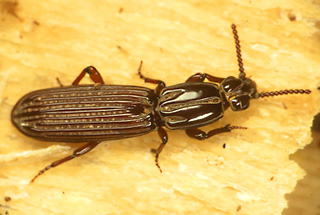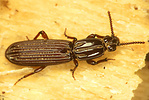Clinidiina
Ross T. BellIntroduction
The Clinidiina is the second largest subtribe of Rhysodini. The group is nearly cosmopolitan. Although entirely absent from Africa, Clinidiina are present in Madagascar. The subtribe is richest in species in the Neotropical Region and in the Oriental Region (excluding India). In most regions, all species have vestigial hind wings, strongly modified eyes, and reduced or modified elytral striae. Winged species, capable of flight and with large, "normal" eyes and complete striation are found only in Madagascar.
A key to the genera of Clinidiina is available here.
Characteristics
In contrast to all other Rhysodini, the minor hairs of the antennae are confined to the ventral surface where they form a narrow band or oval or circular tuft. In a few species they are entirely absent. The apical antennal segment has an apical stylet. The median lobe of the head is short. The frontal grooves are nearly or quite complete. The elytron lacks an apical striole.
Relationships of Clinidiina to Other Rhysodines
This group is apparently phylogenetically isolated by the unique arrangement of minor setae. According to Beutel (personal communication) the structure of the metathorax is more primitive than in other tribes.
References
Bell, R. T. 1973. New species of Clinidium from Guatemala (Coleoptera, Carabidae or Rhysodidae) Proceedings of the Entomological Society of Washington 75(3): 279-282.
Bell, R. T. and J. R. Bell. 1975. Two new taxa of Clinidium (Coleoptera: Rhysodidae or Carabidae) from the Eastern U.S., with a revised key to U.S. Clinidium. The Coleopterists Bulletin 29(2):65-68.
Bell, R. T. and J. R. Bell. 1978. Rhysodini of the World part I. A new classification of the tribe, and a synopsis of Omoglymmius subgenus Nitiglymmius, new subgenus (Coleoptera: Carabidae or Rhysodidae). Quaestiones Entomologicae 14: 43-88.
Bell, R. T. and J. R. Bell. 1979. Rhysodini of the World part II. Revisions of the smaller genera (Coleoptera: Carabidae or Rhysodidae). Quaestiones Entomologicae 15: 377-446.
Bell, R. T. and J. R. Bell. 1985. Rhysodini of the World Part IV. Revisions of Rhyzodiastes and Clinidium, with new species in other genera (Coleoptera: Carabidae or Rhysodidae). Quaestiones Entomologicae 21(1): 1-172.
Bell, R. T. and J. R. Bell. 1987. A new species of Clinidium Kirby (Coleoptera: Carabidae or Rhysodidae) from Mexico, and descriptions of the females of two Neotropical members of the genus. Annals Of The Carnegie Museum 56(8-14): 193-196.
Hovorka, 0. 1997. New Clinidium species from Ecuador (Coleoptera: Carabidae: Rhysodini). Acta Societatis Zoologicae Bohemicae 61(1):19-22.
Title Illustrations

| Scientific Name | Clinidium baldufi |
|---|---|
| Location | Mississippi, U.S.A. |
| Specimen Condition | Live Specimen |
| Image Use |
 This media file is licensed under the Creative Commons Attribution License - Version 3.0. This media file is licensed under the Creative Commons Attribution License - Version 3.0.
|
| Copyright |
© 1997 David R. Maddison

|
About This Page
Ross T. Bell

University of Vermont, Burlington, Vermont, USA
Page copyright © 1999 Ross T. Bell
All Rights Reserved.
- First online 14 December 1999
Citing this page:
Bell, Ross T. 1999. Clinidiina. Version 14 December 1999. http://tolweb.org/Clinidiina/1796/1999.12.14 in The Tree of Life Web Project, http://tolweb.org/










 Go to quick links
Go to quick search
Go to navigation for this section of the ToL site
Go to detailed links for the ToL site
Go to quick links
Go to quick search
Go to navigation for this section of the ToL site
Go to detailed links for the ToL site